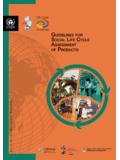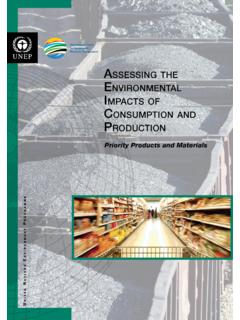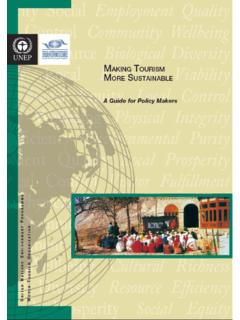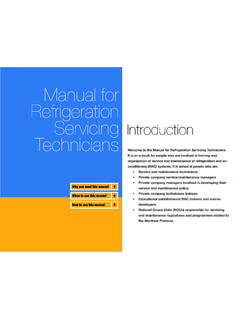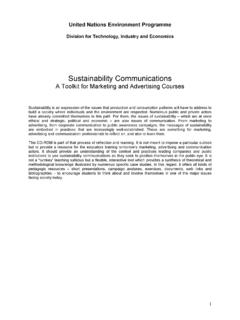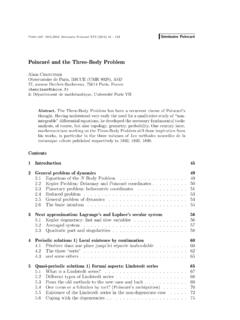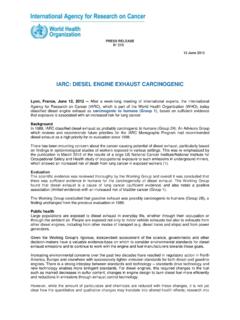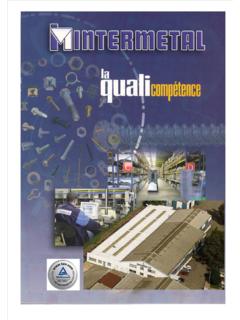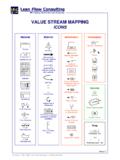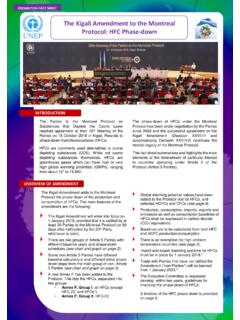Transcription of Manual for Training of Extension Workers and Farmers on ...
1 Manual for Trainingof ExtensionWorkers andFarmers onAlternativesto Methyl Bromidefor Soil FumigationCover photoTraining of trainers: soil solarization and biofumigationManual for Trainingof ExtensionWorkers andFarmers onAlternativesto Methyl Bromidefor Soil FumigationPrepared byR. BragaR. LabradaL. FornasariandN. FratiniThis publication may be reproduced in whole, or in part and in any formfor educational, or non-profit, purposes without special permission fromthe copyright holder, provided that acknowledgment of the source ismade. FAO and UNEP would appreciate receiving a copy of anypublication that uses this publication as a use of this publication may be made for resale, or for any othercommercial purpose whatsoever without prior permission in writingfrom FAO, or UNEP.
2 FAO and UNEP 2001 Contacts:Dr. Ricardo Labrada, Weed OfficerFood and Agriculturen Organization of the United Nations - Plant Protection ServiceVia delle Terme di Caracalla00100 Rome, ITALYTel. +39-0657054079 Fax. +39-0657056347E-mail: : Rajendra Shende, ChiefEnergy and OzonAction UnitDivision of Technology, Industry and EconomicsUnited Nations Environment ProgrammeTour Mirabeau39-43 quai Andr Citroen75739 Paris Cedex 15, FRANCETel. +33 1 44 37 1450 Fax. +33 1 44 37 1474E-mail: document is available on the FAO website at: and on the UNEP OzonAction website at: designations employed and the presentation of the material in thispublication do not imply the expression of any opinion whatsoever onthe part of the Food and Agriculture Organization and theEnvironment Programme of the United Nations concerning the legalstatus of any country, territory, city, or area, or of its authorities, orconcerning delimitation of its frontiers, or boundaries.
3 Moreover, theviews expressed do not necessarily represent the decision of the statedpolicy of the Food and Agriculture Organization and the EnvironmentProgramme of the United Nations, nor does citing the trade names, orcommercial processes constitute PageContentsiiiPREFACE vList of AcronymsviiChapter I. INTRODUCTION 1 Chapter II. Training OF TRAINERS 31. Preparatory workshop 32. The Training of Trainers Basic field experiments Concept-specific learning activities Agro-ecosystem analysis 63. Team building and group dynamics 64. Evaluation 6 Chaper III. Farmers FIELD SCHOOLS 71. Planning 82. Implementation103. Evaluation11 Chapter IV.
4 EXERCISES FOR TOTs and FFSs131. Understanding the soil system132. Assessing soil-borne arthropods (an exercise for FFSs) 153. Assessment of weed stand (an exercise for FFSs) 17 Chapter V. PARTICIPATORY CURRICULUM DEVELOPMENT211. General212. Guidelines213. Topics23 Chaptyer VI. DESCRIPTION OF MAIN ALTERNATIVES271. Non-chemical Cultural practices Physical control 302. Chemical alternatives 30ivUSEFUL BIBLIOGRAPHY 33 USEFUL WEB LINKS 34vPREFACEM ethyl bromide is a broad-spectrum fumigant used worldwide for the control of soil-borne pests. When used as a soil fumigant, methyl bromide gas is usually applied tothe soil before the crop is planted and the soil is then covered with plastic tarps.
5 Thetreatment effectively kills various soil organisms, but once the tarps are removed, partof the gas will eventually enter the presence of bromine in the atmosphere is fatal due to its strong ozone-depletingaction. For this reason methyl bromide use will be reduced and phased out completelyby the end of the year 2015. Moreover, there is increasing resistance to acceptance ofcommodities produced using methyl bromide on the part of consumers. Therefore, it isessential to find appropriate alternatives that can be used effectively for the control ofsoil-borne pests. This approach should aim to make Farmers aware of the need todiscontinue the use of methyl bromide and to educate them in the application of newlydeveloped Integrated Pest Management (IPM) approach is the key to developing acomprehensive Training programme for Farmers on new alternatives.
6 The basis of thisapproach is the Training of Extension Workers and other agents who work closely has shown that the majority of Farmers are not persuaded to apply newinnovative techniques by simple field demonstrations. This approach is a waste of timeand money in many areas where it is implemented. Therefore, the second step in theIPM approach should be the Training of Farmers by building on so-called Farmer FieldSchools where Farmers learn to apply, adapt and improve the new Manual aims to provide guidance to Extension Workers in matters related to thesetting up and conduct of Training of Trainers courses, as well as Farmer FieldSchools, on alternative technologies to replace the use of methyl bromide as a soilfumigant.
7 It provides a framework, relevant information and tools to build on theseactivities according to specific is important to point out that, although FAO has vast experience in IPM projects inmany developing regions of the world (including the setting-up of Farmer FieldSchools), no experience specifically related to methyl bromide yet exists. In time, thismanual will doubtless have to be revised and enriched with new elements andexperience from countries where Farmer Field Schools have been developed forphasing out methyl bromide soil Manual was prepared by a group of specialists familiar with Training of Trainers andFarmer Field Schools.
8 It is aimed at Extension officers and development agents who areviresponsible for assisting those Farmers who at present use methyl bromide as a thank INIAP (Instituto Nacional Aut nomo de Investigaciones Agropecuarias -Ecuador) and CIP (Centro Internacional de la Papa - Per ) for their courtesy to allow theuse of the drawings reproduced (modified) in this publication was prepared by the Food and Agriculture Organization of the UnitedNations (FAO) and sponsored by the United Nations Environment Programme Division of Technology, Industry and Economics (UNEP-DTIE), as part of itsOzonAction Programme under Montreal Protocol s Multilateral BragaEMBRAPA, Fortaleza (BRA)Ricardo LabradaFAO, Rome (I)Luca FornasariMontpellier (F)Nora FratiniRome (I)viiList of Acronyms1I.
9 INTRODUCTIONM ethyl bromide, or bromomethane (MeBr), is a highly effective fumigant used tocontrol soil-borne pests in several crops worldwide. One of its main uses is for soilfumigation of seedbeds of tomatoes, peppers, eggplants, tobacco, strawberries,ornamentals and other crops. It is estimated that more than 80% of the globalconsumption of MeBr is for soil has been defined scientifically as a chemical that depletes the earth s ozonelayer. Its ozone-depletion potential (ODP) is , greater than the admissiblethreshold of Bromine released from applied MeBr is considered to be 40 timesmore efficient than chlorine in breaking down ozone, on a per atom this information has led to a planned phase-out process in developed anddeveloping countries, under the Montreal Protocol on substances that deplete theozone layer.
10 The complete phase-out of MeBr in developed countries is foreseen by2005, while in developing countries a reduction should take place during the 2000swith the process completed by the end of phase-out implies that countries should develop viable alternatives to replace thepresent use of MeBr. These alternatives should be technically effective in controllingsoil-borne pests, environmentally safe, easy to use and economically feasible forfarmers. In many cases, it is unlikely that a single control alternative will be availableto replace MeBr. It would probably be necessary to combine two, or more, controlmeasures in order to achieve results as technically effective as of Integrated Pest Management (IPM) is also part of the solution.
